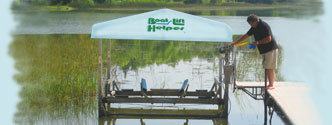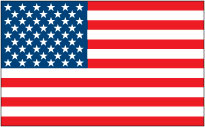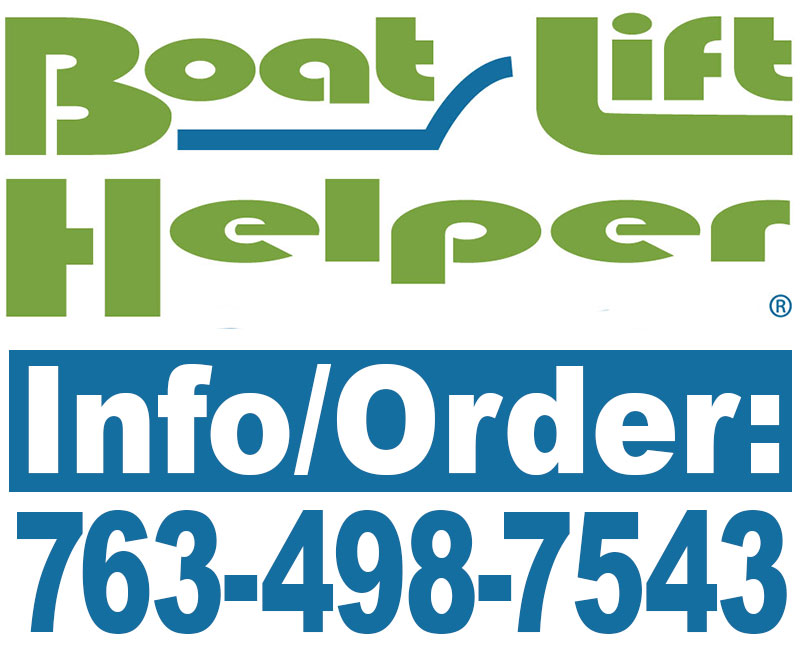For More Information, Or To Order
Contact Boat Lift Helper:
Email: tim@boatlifthelper.com
A Three Year Warranty
Provides added assurance of our product's quality and business integrity.
____________________________
Boat Lift Helper ®
User Guide & Safety Warnings
 * The Boat Lift Helper is extremely easy to use, but it’s important to observe the following safety
measures to prevent property damage or serious personal injury. In addition to these precautions,
normal personal safety procedures should be exercised while working near the water.
* The Boat Lift Helper is extremely easy to use, but it’s important to observe the following safety
measures to prevent property damage or serious personal injury. In addition to these precautions,
normal personal safety procedures should be exercised while working near the water.
Completely read instructions in the
Installation Guide before use.
![]() Attachment of the air-lift-bags should be at the front (bow) and rear (stern) of the lift to provide
optimum stability. Position the air-lift-bags left or right to balance off center items such as the crank.
Attachment of the air-lift-bags should be at the front (bow) and rear (stern) of the lift to provide
optimum stability. Position the air-lift-bags left or right to balance off center items such as the crank.
![]() Do not drag air-lift-bags across the ground, damage may occur as a result. After placing your lift in the
water, start by inflating one air-lift-bag. When it rises to the surface continue inflating until it appears FIRM (Min. 2.5 P.S.I.). Repeat on the second bag. This will help to maintain stability of the lift.
Do not drag air-lift-bags across the ground, damage may occur as a result. After placing your lift in the
water, start by inflating one air-lift-bag. When it rises to the surface continue inflating until it appears FIRM (Min. 2.5 P.S.I.). Repeat on the second bag. This will help to maintain stability of the lift.
![]() When the lift is positioned in the chosen location, FULLY deflate one air-lift-bag until the lift legs on
that side are resting on the lake bottom before you begin to deflate the second bag. This will help to
maintain stability to the lift. Test lift to ensure it has settled firm to the bottom.
When the lift is positioned in the chosen location, FULLY deflate one air-lift-bag until the lift legs on
that side are resting on the lake bottom before you begin to deflate the second bag. This will help to
maintain stability to the lift. Test lift to ensure it has settled firm to the bottom.
![]() When removing your lift, start by inflating one air-lift-bag. When it rises to the surface continue
inflating until it appears FIRM (Min. 2.5 P.S.I.). Repeat on the second bag. This will help to maintain
stability of the lift.
When removing your lift, start by inflating one air-lift-bag. When it rises to the surface continue
inflating until it appears FIRM (Min. 2.5 P.S.I.). Repeat on the second bag. This will help to maintain
stability of the lift.
![]() Do not inflate the air-lift-bags or move the boat lift with the lift canopy installed, it may work as a sail
if the wind suddenly increases.
Do not inflate the air-lift-bags or move the boat lift with the lift canopy installed, it may work as a sail
if the wind suddenly increases.
![]() Do not inflate the air-lift-bags with the boat on the lift. This will cause damage to the air bags, lift, or
boat and may cause harm to the operator.
Do not inflate the air-lift-bags with the boat on the lift. This will cause damage to the air bags, lift, or
boat and may cause harm to the operator.
![]() Do not install or raise boat lift when wind, waves, or current may interfere with safe control of the
floating lift.
Do not install or raise boat lift when wind, waves, or current may interfere with safe control of the
floating lift.
![]() Do not install the system unless a dock or other high stable structure is in the water to walk on to get higher leverage on the lift.
Do not install the system unless a dock or other high stable structure is in the water to walk on to get higher leverage on the lift.
![]() Do not climb on the floating boat lift or use the Boat Lift Helper as a flotation or personal safety device.
Do not climb on the floating boat lift or use the Boat Lift Helper as a flotation or personal safety device.
![]() Do not tow or move a floated lift over open water or float the lift to a different location on the lake.
Do not tow or move a floated lift over open water or float the lift to a different location on the lake.
![]() The lift can be easily moved, however for safety always have a minimum of two people handle the lift in case of; changing wind, balance, water conditions, or any unforeseen problems that may arise during operation.
The lift can be easily moved, however for safety always have a minimum of two people handle the lift in case of; changing wind, balance, water conditions, or any unforeseen problems that may arise during operation.
![]() For security, tether the boat lift to a dock in case wind or water conditions should change. Failure to
secure the lift could cause a lack of control over the floating lift.
For security, tether the boat lift to a dock in case wind or water conditions should change. Failure to
secure the lift could cause a lack of control over the floating lift.
![]() Avoid being positioned between the lift and dock. Injury could result from unexpected movement.
Avoid being positioned between the lift and dock. Injury could result from unexpected movement.
![]() Do not have heavy accessories on the boat lift (such as batteries, etc.) until the lift has been moved into position
and the air-lift-bags have been deflated as they may make the lift weight distribution severely unbalanced.
Do not have heavy accessories on the boat lift (such as batteries, etc.) until the lift has been moved into position
and the air-lift-bags have been deflated as they may make the lift weight distribution severely unbalanced.
![]() Water in the lift’s beams or mud on the pads when re-floating your air-lift-bags may create instability
as the lift rises.
Water in the lift’s beams or mud on the pads when re-floating your air-lift-bags may create instability
as the lift rises.
![]() Do not attempt to lift more than the recommend weight for the air-lift-bags (800 lbs. maximum per pair with the standard version).
Do not attempt to lift more than the recommend weight for the air-lift-bags (800 lbs. maximum per pair with the standard version).
![]() Electrical Shock Hazard – Use of electric powered tools near water, in damp areas and on metal
docks is inherently dangerous. Extreme caution is recommended in use of powered tools like air
pumps near the water.
Electrical Shock Hazard – Use of electric powered tools near water, in damp areas and on metal
docks is inherently dangerous. Extreme caution is recommended in use of powered tools like air
pumps near the water.
*![]() SAFETY WARNING: Not following instructions or observing safety warnings could result in
property damage, severe personal injury, or even death.
SAFETY WARNING: Not following instructions or observing safety warnings could result in
property damage, severe personal injury, or even death.
________________________
There is a 20% restocking fee for unused kits returned (freight prepaid). Credit less the cost of initial shipment and handling.
Boat Lift Helper® , Easy-Float® , Lift-Launch® , Float Your Boat Lift® and the Boat Lift Helper®
logos are Registered Trademarks and the property of Mans & Co LLC.
Boat Lift Helper® is protected by U.S. Patent #8123433,
and Canada Patent Pending






